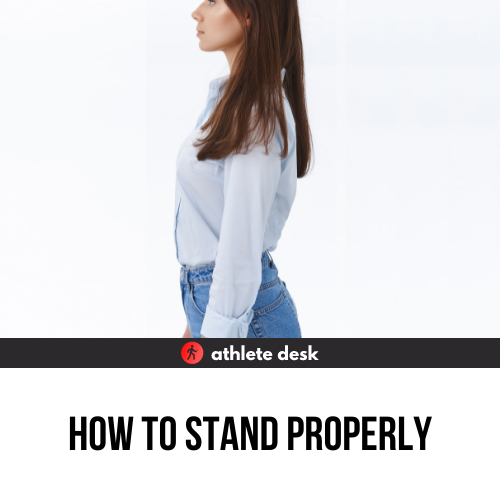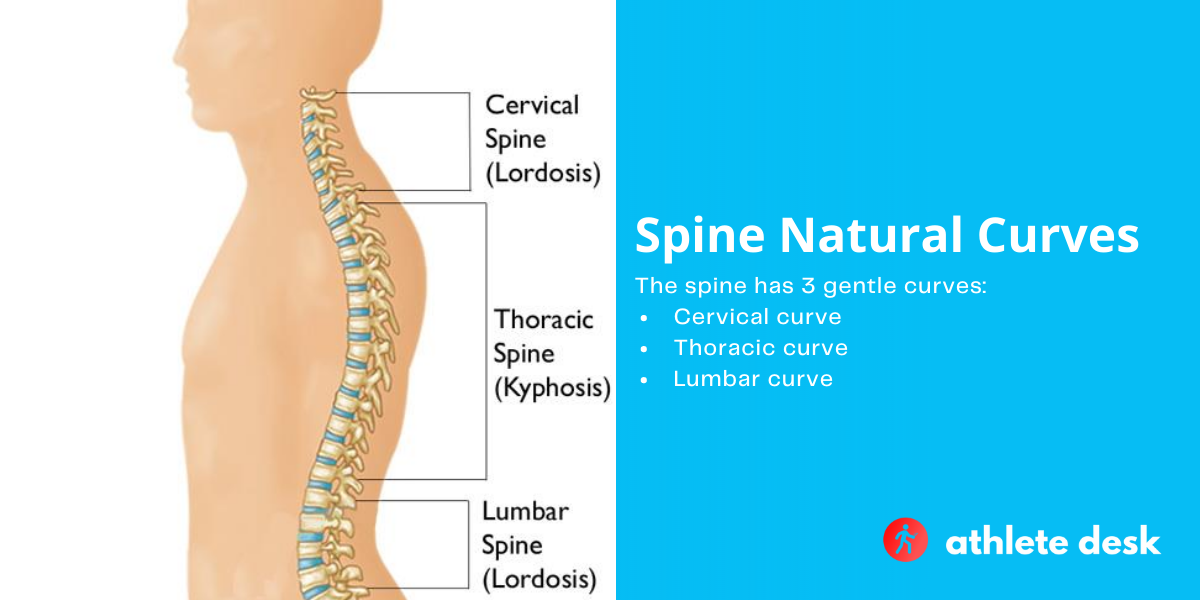To stand properly make sure you maintain the natural curves of your spine without exaggerating them.
Keep your shoulders back and line up your ears, shoulders, hips, and ankles.
Do not lock your knees, and let your legs sit shoulder-width apart.
Your hands should rest at your sides naturally.
Standing properly goes beyond keeping your entire body in a straight line, and you need to understand what is the most natural standing form. Keep reading to explore the neutral stance and some tips for maintaining it.

Proper Standing Posture
Proper standing posture involves recognizing and maintaining the way that our body is supposed to stand.
This is not a militant, pole-straight posture.
To stand properly, you want your body to line up in the way that is best equipped to combat gravity without causing unnecessary stress to your muscles.
Understanding the Natural Curves of Your Spine:
Before you can learn how to stand properly, you need to understand the natural curvature of your spine.
Contrary to popular belief, your spine does not sit straight with vertebrae stacked directly on top of each other.

There are three gentle curves to offer you better control over different parts o your body:
- Cervical curve
- Thoracic curve
- Lumbar curve
The cervical curve is an inward curve that seems to set your neck a bit forward, while the thoracic curve is what positions your upper back slightly outward or back.
The spine turns inward again at the lumbar curve.
Keep these curves in mind when figuring out your proper standing position.
Lower Body:
You can adjust your body in whichever order works best, but starting from the ground up can offer the most stability.
Your lower body consists of the parts underneath your waist, paying special attention to your:
- Feet
- Ankles
- Knees
- Pelvis/hips
Start with your feet standing shoulder-width apart.
Try to keep them pointed straight, and keep in mind that you should be shifting your weight as you stand.
Draw a line from your ankles to your hips, keeping your knees close to neutral without locking them.
They’ll likely sit just in front of the line, but if you lock them it will force your pelvis and chest to turn out improperly.
In most cases, you should be able to keep your pelvis neutral, but make sure it isn’t turned too far the other way.
Read More >> Why Do I Lock My Knees When I Stand?
Upper Body:
When focusing on the line of posture, you want your shoulder and ears in line with your ankles and hips.
Keep your sternum/chest up and out without pushing them too far forward.
This, as well as pulling your shoulder back slightly, limits slouching.
Make sure your shoulders don’t float up by your ears as you stand.
Your head, which weighs about 15 lbs, should sit further back so your neck and shoulders don’t need to work as hard to keep it upright.
Focus on maintaining the natural curves of your spine without exaggerating them or straightening them.
Testing for Proper Standing Posture
It’s hard to be sure that you are standing properly. Try these two tests to ensure proper posture, but keep in mind that they rely on your judgment.
Good basic knowledge of posture is essential for proper evaluation.
The Wall Test:
Stand with your head, shoulder blades, and buttocks pressed up against your wall, but keep your heels about 3 inches from it.
Take your hand and slip it into the lumbar curve of your lower back. For proper measurement make sure your palm presses flat against the wall.
If your back is aligned properly, the thickness of your hand should fill the space perfectly.
If there is too much space, try to diminish it by tightening your abs to flatten the lumbar curve. With too little space, untuck your pelvis a few degrees until your hand fits comfortably.
Once you make the proper adjustments, walk away from the wall and take the time to remember how this posture feels. This won’t immediately fix your issues, but it should draw attention to them.
Mirror Checks:
Alternatively, you can check your posture in the mirror or recruit someone else to visually check your posture.
This only works if you or your spotter know what to look for when standing properly. Familiarize yourself with the proper posture guidelines mentioned before, then make adjustments in real-time.
Pay attention to your body’s default standing posture. This shows you what you need to look out for the most.
You should also take note of any weaknesses you feel when making adjustments. This tells you which muscles to work on to facilitate proper standing posture.
Tips for Standing Properly
Standing properly is more than just taking a form and freezing there.
Because no posture is completely static, you need to take advantage of tips and tools to maintain proper posture.
Pay attention to special conditions and make sure you develop the right skills and muscles.
Carrying a Bag:
Bags that rest on a single-arm are more detrimental to your posture. The weight pulls down on the single shoulder it sits on, straining the muscle and throwing off your balance.
Even an empty bag will affect your balance and posture; your shoulder must tense up and adjust to keep the straps on your shoulder.
Instead, opt for cross-body bags or backpacks. These distribute the work more effectively and limit any effects on how you stand.

Checking Your Phone:
Limit the time you spend checking your phone or looking at anything else when standing.
Phones are the main culprit, leading you to look down and flex the muscles in your neck. This causes unnecessary stress on your cervical spine.
If you need to look at your phone, bring it as close to eye level as you can. This limits the degree of strain you impose on your neck and cervical vertebrae.
Mindfulness:
Simply being aware of your body and how it is positioned will help you improve your posture in the moment and over time.
Utilizing mirror checks is a great way to do this, but you should reach a point where you can identify the feel of proper and improper posture.
Memorize how the muscles in your body feel when you stand properly.
Meditation and yoga can help you develop your mindfulness skills.
Exercise and Maintaining a Healthy Weight:
Yoga and Tai Chi are also great for developing the muscles that you need to stand properly, but any exercise will do.
Exercises that strengthen your core (back, abdomen, and pelvis) will give you more power to make and maintain the proper adjustments.
Exercise helps you reach and maintain a healthy weight.
Extra weight can weaken your abdominal muscles, creating problems for your pelvis and spine and contributing to lower back pain.
Attire:
Apart from carrying a bag properly, opt for comfortable clothing that does not force you to adjust your posture.
Ill-fitted clothes, usually those that are too small, can cause you to subconsciously adjust your posture.
Heels are fine to wear from time to time, but you should be aware of how they throw off your balance and cause you to walk differently.
This causes more stress to your muscles.
You can also check out the Upright GO 2 Posture Trainer and Corrector, which is a great product, that trains you to correct your posture either sitting or standing:
- WHAT IS UPRIGHT? This tiny device gives you gentle vibrating reminders when you slouch. You slouch because you forget to stay up right (we all do); but Upright makes remembering easy!
- EASY SET UP: Simply place it on your back with the adhesive or necklace (sold separately) and get real time posture feedback via the device and track progress via the app.
The Importance of Proper Standing Posture
Standing properly goes beyond looking great.
It is one of the most effective ways to maintain your body and prevent damage, both short-term discomforts and long-term injuries.
Proper standing posture takes advantage of your body’s optimal alignment.
Preventing Muscle Strain:
If you’ve ever slouched in your chair you understand how improper posture can lead to soreness and muscle strain.
Read More >> What is the Best Posture for Sitting at a Desk?
While the effects are not obvious as immediately when standing, slouching and other poor postures will strain different sets of muscles.
This is when you start to notice pain in your neck, shoulders, and lower back, although all areas of your body can be affected.
The body is best equipped to handle standing and anything it entails when you enforce proper posture.
Limiting Abnormal Wear:
On top of straining your muscles, standing with poor posture will wear down on your joints and ligaments as well.
Your muscles are one thing, but the points where your body folds and turns can perform poorly under stress.
Abnormal wear can lead to greater injuries and long-term effects, such as arthritis.
By limiting the abnormal wear on your joints your body can work more efficiently, limiting pain and getting more done.
Flexibility and Balance:
When you limit the strain on muscles and joints they maintain their flexibility.
This creates a proper basis for mobility and coordination, and it further limits your chance of injuries.
Because your muscles operate most efficiently, your body and mind do less work to recalibrate balance.
This reduces opportunities when you lose your balance and lets your subconscious focus on other tasks.
Allowing Digestion:
A less direct effect is how proper posture aids digestion. Standing properly makes sure everything inside aligns properly for digestion.
When you slouch it can trigger heartburn or acid reflux.
Poor posture puts pressure on the abdominal region, often forcing stomach acid up.
Even laying down after eating can cause problems by encouraging food to move in the opposite direction.
Your best bet is standing tall and straight after eating, especially if you already suffer from acid reflux.
Learning how to stand properly can only improve your health, while poor posture can only lead to problems.
Last update on 2022-12-21 / Affiliate links / Images from Amazon Product Advertising API









